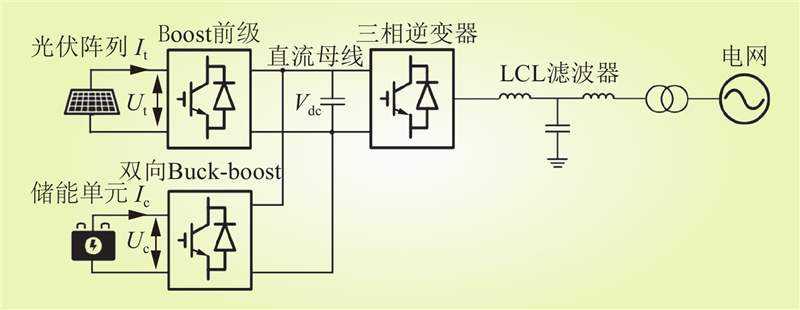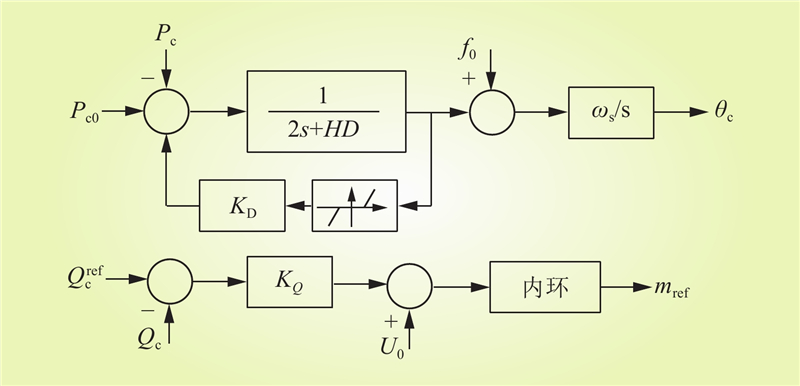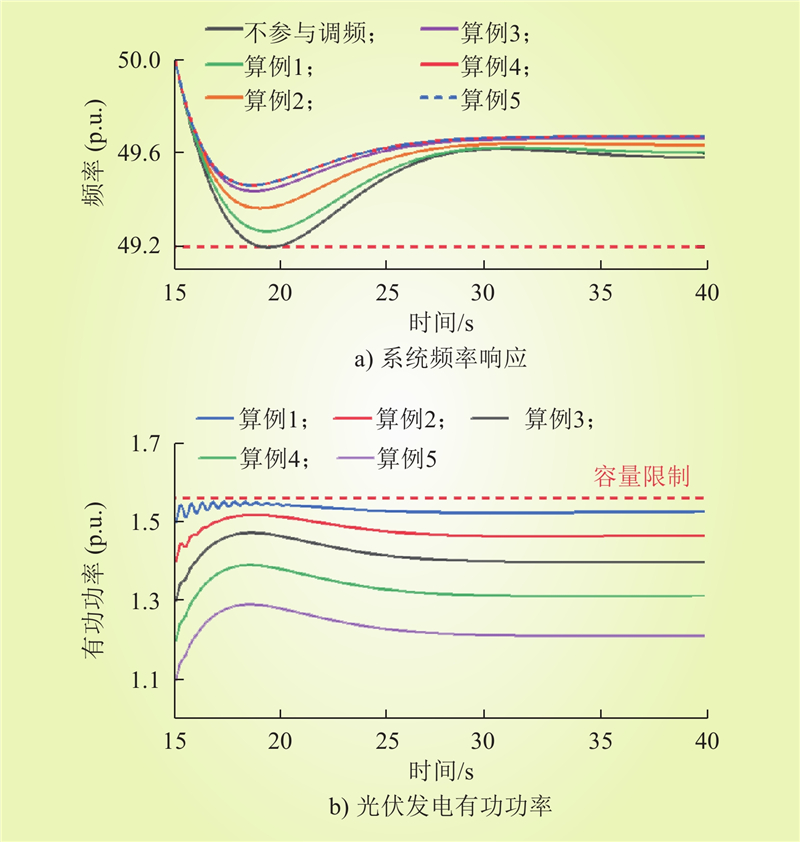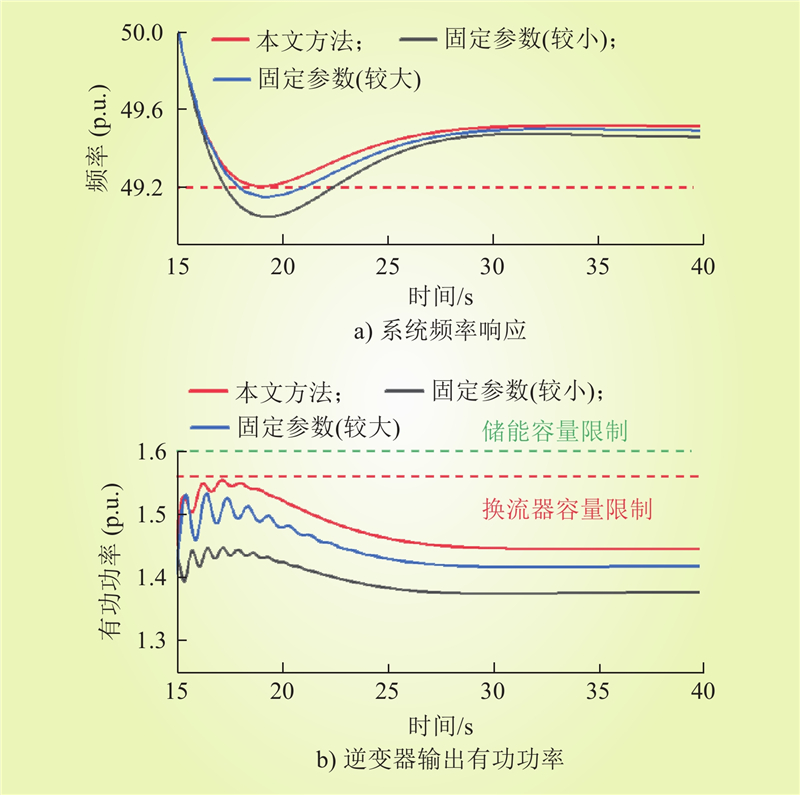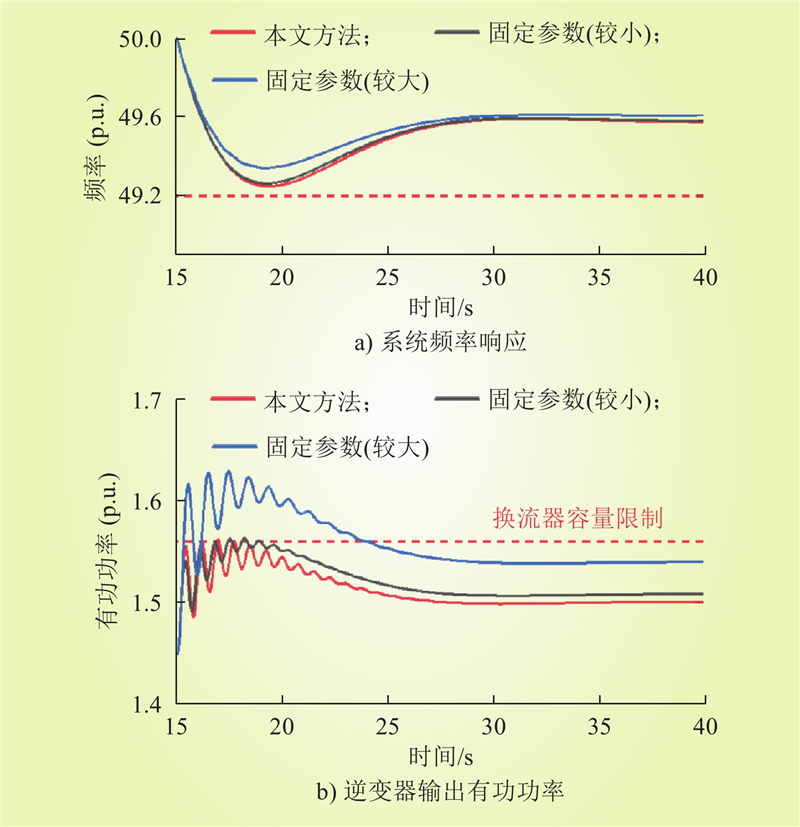| 1 |
RATNAM K S, PALANISAMY K, YANG G Y. Future low-inertia power systems: Requirements, issues, and solutions - A review[J]. Renewable and Sustainable Energy Reviews, 2020, 124, 109773.
DOI
|
| 2 |
谭显东, 刘俊, 徐志成, 等. “双碳” 目标下“十四五” 电力供需形势[J]. 中国电力, 2021, 54 (5): 1- 6.
|
|
TAN Xiandong, LIU Jun, XU Zhicheng, et al. Power supply and demand balance during the 14th five-year plan period under the goal of carbon emission peak and carbon neutrality[J]. Electric Power, 2021, 54 (5): 1- 6.
|
| 3 |
国家能源局. 新型电力系统发展蓝皮书[M]. 北京: 中国电力出版社, 2023.
|
| 4 |
汪梦军, 郭剑波, 马士聪, 等. 新能源电力系统暂态频率稳定分析与调频控制方法综述[J]. 中国电机工程学报, 2023, 43 (5): 1672- 1694.
|
|
WANG Mengjun, GUO Jianbo, MA Shicong, et al. Review of transient frequency stability analysis and frequency regulation control methods for renewable power systems[J]. Proceedings of the CSEE, 2023, 43 (5): 1672- 1694.
|
| 5 |
胡安平, 杨波, 潘鹏鹏, 等. 基于电力电子接口的储能系统惯性特征研究[J]. 中国电机工程学报, 2018, 38 (17): 4999- 5008, 5297.
|
|
HU Anping, YANG Bo, PAN Pengpeng, et al. Study on inertial characteristics of energy storage system with power electronic interface[J]. Proceedings of the CSEE, 2018, 38 (17): 4999- 5008, 5297.
|
| 6 |
刘勃, 陈中, 王毅, 等. 基于斜坡渐变扰动的新型电力系统等效惯量评估[J]. 电力自动化设备, 2024, 44 (3): 49- 56.
|
|
LIU Bo, CHEN Zhong, WANG Yi, et al. Ramp gradient disturbance based equivalent inertia estimation of new type power system[J]. Electric Power Automation Equipment, 2024, 44 (3): 49- 56.
|
| 7 |
BANDYOPADHYAY S, PURGAT P, QIN Z A, et al. A multiactive bridge converter with inherently decoupled power flows[J]. IEEE Transactions on Power Electronics, 2021, 36 (2): 2231- 2245.
DOI
|
| 8 |
谢小荣, 贺静波, 毛航银, 等. “双高” 电力系统稳定性的新问题及分类探讨[J]. 中国电机工程学报, 2021, 41 (2): 461- 475.
|
|
XIE Xiaorong, HE Jingbo, MAO Hangyin, et al. New issues and classification of power system stability with high shares of renewables and power electronics[J]. Proceedings of the CSEE, 2021, 41 (2): 461- 475.
|
| 9 |
王博, 杨德友, 蔡国伟. 高比例新能源接入下电力系统惯量相关问题研究综述[J]. 电网技术, 2020, 44 (8): 2998- 3007.
|
|
WANG Bo, YANG Deyou, CAI Guowei. Review of research on power system inertia related issues in the context of high penetration of renewable power generation[J]. Power System Technology, 2020, 44 (8): 2998- 3007.
|
| 10 |
方勇杰. 英国“8·9” 停电事故对频率稳定控制技术的启示[J]. 电力系统自动化, 2019, 43 (24): 1- 5.
DOI
|
|
FANG Yongjie. Reflections on frequency stability control technology based on the blackout event of 9 August 2019 in UK[J]. Automation of Electric Power Systems, 2019, 43 (24): 1- 5.
DOI
|
| 11 |
张武其, 文云峰, 迟方德, 等. 电力系统惯量评估研究框架与展望[J]. 中国电机工程学报, 2021, 41 (20): 6842- 6856.
|
|
ZHANG Wuqi, WEN Yunfeng, CHI Fangde, et al. Research framework and prospect on power system inertia estimation[J]. Proceedings of the CSEE, 2021, 41 (20): 6842- 6856.
|
| 12 |
秦晓辉, 苏丽宁, 迟永宁, 等. 大电网中虚拟同步发电机惯量支撑与一次调频功能定位辨析[J]. 电力系统自动化, 2018, 42 (9): 36- 43.
DOI
|
|
QIN Xiaohui, SU Lining, CHI Yongning, et al. Functional orientation discrimination of inertia support and primary frequency regulation of virtual synchronous generator in large power grid[J]. Automation of Electric Power Systems, 2018, 42 (9): 36- 43.
DOI
|
| 13 |
孙华东, 王宝财, 李文锋, 等. 高比例电力电子电力系统频率响应的惯量体系研究[J]. 中国电机工程学报, 2020, 40 (16): 5179- 5192.
|
|
SUN Huadong, WANG Baocai, LI Wenfeng, et al. Research on inertia system of frequency response for power system with high penetration electronics[J]. Proceedings of the CSEE, 2020, 40 (16): 5179- 5192.
|
| 14 |
詹长江, 吴恒, 王雄飞, 等. 构网型变流器稳定性研究综述[J]. 中国电机工程学报, 2023, 43 (6): 2339- 2359.
|
|
ZHAN Changjiang, WU Heng, WANG Xiongfei, et al. An overview of stability studies of grid-forming voltage source converters[J]. Proceedings of the CSEE, 2023, 43 (6): 2339- 2359.
|
| 15 |
罗澍忻, 韩应生, 余浩, 等. 构网型控制在提升高比例新能源并网系统振荡稳定性中的应用[J]. 南方电网技术, 2023, 17 (5): 39- 48.
|
|
LUO Shuxin, HAN Yingsheng, YU Hao, et al. Application of grid-forming control in improving the oscillation stability of power systems with high proportion renewable energy integration[J]. Southern Power System Technology, 2023, 17 (5): 39- 48.
|
| 16 |
王吉利, 占领, 张钢, 等. 提高构网型储能系统功角稳定性的附加阻尼方法[J]. 电力科学与技术学报, 2023, 38 (4): 75- 81, 103.
|
|
WANG Jili, ZHAN Ling, ZHANG Gang, et al. Additional damping method for improving the power angle stability of grid-forming energy storage system[J]. Journal of Electric Power Science and Technology, 2023, 38 (4): 75- 81, 103.
|
| 17 |
杜夏恒, 赫玉莹, 邹文, 等. 跟网型和构网型逆变器的阻抗无源化方法综述[J]. 东北电力大学学报, 2024, 44 (2): 12- 20.
|
|
DU Xiaheng, HE Yuying, ZOU Wen, et al. An overview of impedance passivation methods forGrid-following and grid-forming inverters[J]. Journal of Northeast Electric Power University, 2024, 44 (2): 12- 20.
|
| 18 |
李建林, 丁子洋, 刘海涛, 等. 构网型储能变流器及控制策略研究[J]. 发电技术, 2022, 43 (5): 679- 686.
DOI
|
|
LI Jianlin, DING Ziyang, LIU Haitao, et al. Research on grid-forming energy storage converters and control strategies[J]. Power Generation Technology, 2022, 43 (5): 679- 686.
DOI
|
| 19 |
范宸珲, 秦晓辉, 齐磊, 等. 构网型下垂控制中虚拟阻抗的作用、改进及研究前景分析[J/OL]. 电网技术: 1–17.
|
|
2024-06-11). https: //doi. org/10.13335/j. 1000-3673. pst. 2024.0189. Fan Chenhui, Qin Xiaohui, Qi Lei, et al. Analysis of the Role, Improvement, and Research Prospects of Virtual Impedance in Grid-forming Droop Control[J/OL]. Power System Technology: 1–17. (2024-06-11). https://doi.org/10.13335/j.1000-3673.pst.2024.0189.
|
| 20 |
粟世玮, 胡钰焓, 王相, 等. 计及储能荷电状态约束的输配协同机组组合优化[J]. 智慧电力, 2023, 51 (11): 69- 75.
DOI
|
|
SU Shiwei, HU Yuhan, WANG Xiang, et al. Unit commitment optimization of transmission and distribution coordination with state of charge constraint of energy storage[J]. Smart Power, 2023, 51 (11): 69- 75.
DOI
|
| 21 |
任大伟, 侯金鸣, 肖晋宇, 等. 支撑双碳目标的新型储能发展潜力及路径研究[J]. 中国电力, 2023, 56 (8): 17- 25.
|
|
REN Dawei, HOU Jinming, XIAO Jinyu, et al. Research on development potential and path of new energy storage supporting carbon peak and carbon neutrality[J]. Electric Power, 2023, 56 (8): 17- 25.
|
| 22 |
李鲁阳, 陈龙翔, 陈磊, 等. 用于新能源一次调频的储能经济配置研究[J/OL]. 中国电力, 2023: 1–12. (2023-11-20). https://kns.cnki.net/kcms/detail/11.3265.TM.20231117.1545.016.html.
|
|
LI Luyang, CHEN Longxiang, CHEN Lei, et al. Research on economic configuration of energy storage for assisting new energy in primary frequency regulation[J/OL]. Electric Power, 2023: 1–12. (2023-11-20). https://kns.cnki.net/kcms/detail/11.3265.TM.20231117.1545.016.html.
|
| 23 |
OUDALOV A, CHARTOUNI D, OHLER C. Optimizing a battery energy storage system for primary frequency control[J]. IEEE Transactions on Power Systems, 2007, 22 (3): 1259- 1266.
DOI
|
| 24 |
DELILLE G, FRANCOIS B, MALARANGE G. Dynamic frequency control support by energy storage to reduce the impact of wind and solar generation on isolated power system's inertia[J]. IEEE Transactions on Sustainable Energy, 2012, 3 (4): 931- 939.
DOI
|
| 25 |
KNAP V, CHAUDHARY S K, STROE D I, et al. Sizing of an energy storage system for grid inertial response and primary frequency reserve[J]. IEEE Transactions on Power Systems, 2016, 31 (5): 3447- 3456.
DOI
|
| 26 |
KE D P, CHUNG C Y, XU J, et al. Inertia emulation uncorrelated with electromechanical dynamics to improve frequency transients using center of inertia (COI) frequency signal[J]. IEEE Transactions on Power Systems, 2021, 36 (3): 1736- 1749.
DOI
|
| 27 |
赵晶晶, 徐传琳, 吕雪, 等. 微电网一次调频备用容量与储能优化配置方法[J]. 中国电机工程学报, 2017, 37 (15): 4324- 4332, 4572.
|
|
ZHAO Jingjing, XU Chuanlin, LÜ Xue, et al. Optimization of micro-grid primary frequency regulation reserve capacity and energy storage system[J]. Proceedings of the CSEE, 2017, 37 (15): 4324- 4332, 4572.
|
| 28 |
HERNÁNDEZ J C, BUENO P G, SANCHEZ-SUTIL F. Enhanced utility-scale photovoltaic units with frequency support functions and dynamic grid support for transmission systems[J]. IET Renewable Power Generation, 2017, 11 (3): 361- 372.
DOI
|
| 29 |
LIU Y, YIN Y W, SUN B, et al. Coordinated frequency regulation strategy of pumped storage units and battery energy storage system[C]//2021 IEEE Sustainable Power and Energy Conference (iSPEC). Nanjing, China. IEEE, 2021: 1195–1200.
|
| 30 |
郭强, 陈崇德, 胡阳, 等. 飞轮和锂电池储能联合光伏发电一次调频控制[J]. 电力系统及其自动化学报, 2023, 35 (11): 1- 9.
|
|
GUO Qiang, CHEN Chongde, HU Yang, et al. Flywheel and lithium battery energy storage combined with photovoltaic power generation participating in primary frequency regulation control[J]. Proceedings of the CSU-EPSA, 2023, 35 (11): 1- 9.
|
| 31 |
刘军, 朱世祥, 柳盼攀, 等. 考虑系统频率安全稳定约束的风储联合频率响应控制策略[J]. 电力系统保护与控制, 2024, 52 (1): 73- 84.
|
|
LIU Jun, ZHU Shixiang, LIU Panpan, et al. Coordinated control strategy for wind turbine and energy storage equipment considering system frequency safety and stability constraints[J]. Power System Protection and Control, 2024, 52 (1): 73- 84.
|



